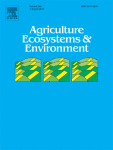View Item
- xmlui.general.dspace_homeCentros Regionales y EEAsCentro Regional Entre RíosEEA ParanáArtículos científicosxmlui.ArtifactBrowser.ItemViewer.trail
- DSpace Home
- Centros Regionales y EEAs
- Centro Regional Entre Ríos
- EEA Paraná
- Artículos científicos
- View Item
Multi-level analysis of bird abundance and damage to crop fields
Abstract
Bird damage to agricultural crops is an important cause of economic loss for farmers worldwide. Predictive habitat models relating bird abundance and damage to characteristics of the agricultural environment at multiple scales are a key tool for designing management programs to reduce impacts of birds on agricultural production. In this study, we explored habitat features influencing abundance and damage of monk parakeets (Myiopsitta monachus) to corn
[ver mas...]
Bird damage to agricultural crops is an important cause of economic loss for farmers worldwide. Predictive habitat models relating bird abundance and damage to characteristics of the agricultural environment at multiple scales are a key tool for designing management programs to reduce impacts of birds on agricultural production. In this study, we explored habitat features influencing abundance and damage of monk parakeets (Myiopsitta monachus) to corn (Zea mays) and sunflower (Helianthus annuus) fields, as a basis for the design and evaluation of management strategies for preventing damage in the future. Using a multi-level approach, we evaluated within-field, field, and landscape variables at three spatial scales potentially related to monk parakeet abundance and damage in crop fields. Monk parakeet abundance and damage was greater in sunflower than in corn fields. Landscape variables, such as distance to nearest site with trees, percentage of landscape with trees, and availability of foraging sites for monk parakeets around the crop fields were more important than local variables in explaining monk parakeet damage to crop fields. However, local variables, such as field area, plant density and percentage of field border with trees, also were related to damage. Relationships varied depending on the crop under consideration and spatial scale of analysis. Based on this study, managers should consider both local and landscape factors when planning management measures to prevent bird damage to crops.
[Cerrar]

Author
Canavelli, Sonia Beatriz;
Branch, Lyn C.;
Cavallero, Pedro;
González, Cristina;
Zaccagnini, Maria Elena;
Fuente
Agriculture, ecosystems & environment 197 (1) : 128-136. (December 2014)
Date
2014-12
Editorial
Elsevier
ISSN
0167-8809
Formato
pdf
Tipo de documento
artículo
Palabras Claves
Derechos de acceso
Restringido
 Excepto donde se diga explicitamente, este item se publica bajo la siguiente descripción: Creative Commons Attribution-NonCommercial-ShareAlike 2.5 Unported (CC BY-NC-SA 2.5)
Excepto donde se diga explicitamente, este item se publica bajo la siguiente descripción: Creative Commons Attribution-NonCommercial-ShareAlike 2.5 Unported (CC BY-NC-SA 2.5)

